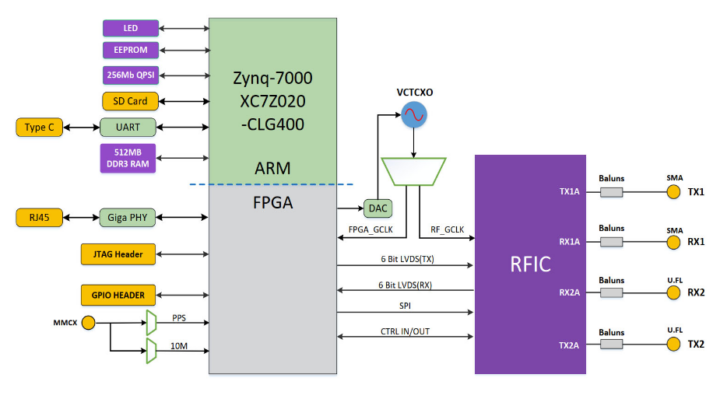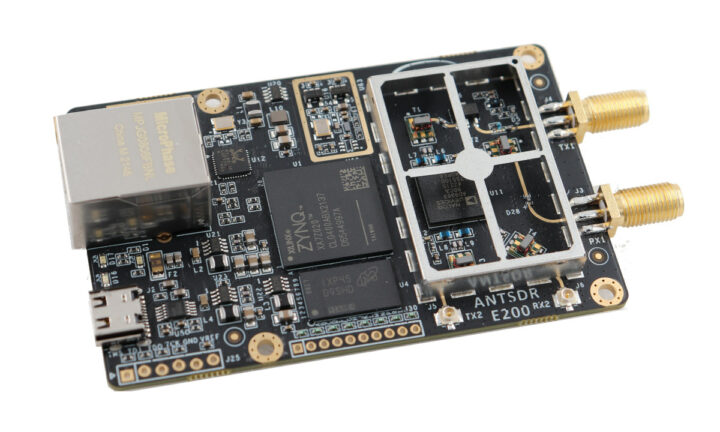We’ve just written about the uSDR M.2 SDR module on Crowd Supply, but it turns out the crowdfunding platform is hosting another SDR (Software-Defined Radio) project with the AntSDR E200 board equipped with an AMD Embedded Zynq 7020 SoC FPGA and an Analog Devices AD9363 or AD9361 RF chipset, and providing Gigabit Ethernet connectivity to the host.
The board can operate in the 70 MHz – 6 GHz range with the AD9361 chipset, and the 325 MHz – 3.8 GHz range with the AD9363, supports 2×2 MIMO with two SMA antenna connectors and two U.FL connectors, and also features expansion interfaces for GPIOs.
AntSDR E200 specifications:
- SoC FPGA – AMD Embedded/Xilinx Zynq 7020 dual-core Arm Cortex-A9 processor and FPGA with 85K logic cells, 4.9Mb Block RAM, 220 DSP slices
- System Memory – 512MB DDR3
- Storage – 256 Mbit QSPI flash for firmware; microSD card slot (bottom side)
- RF
- Chipset – Analog Devices AD9363 or AD9361
- Channels – 2 × 2 MIMO
- Sample Rate: 200 KHz – 61.44 MHz
- Tuning Range – AD9363: 325 MHz – 3.8 GHz, AD9361: 70 MHz – 6 GHz
- RF bandwidth – AD9363: 200 KHz – 20 MHz, AD9361: 200 KHz – 56 MHz
- RF Transmit Power – Up to 10 dBm
- Antenna connectors – 2 SMA and 2 U.FL connectors
- Networking – Gigabit Ethernet RJ45 port
- USB – USB Type-C port for serial access and power
- Expansion – 8x PL GPIO interfaces
- Clock System – 40M VCXO and PPS/10M Reference clock input
- Debugging – FPGA JTAG connector for external JTAG programmer/debugger

On the software side, the AntSDR E200 board relies on Analog Devices’ LibIIO library for interfacing with Linux IIO (Industrial Input/Output) devices and the USRP Hardware Driver (UHD) is an open-source, cross-platform driver which MicroPhase Technology – the company being the AntSDR E200 – ported to the SDR board. They’ve also written two different firmware, the first one to make the board compatible with the ADALM-PLUTO evaluation kit and the other with basic UHD components, enabling AntSDR to communicate with the host. You’ll find the source code and PDF schematics on GitHub, as well as online documentation on Read the Docs.
So what exactly can you do with the AnSDR E200 board? Potential applications include Ham radio, air traffic monitoring, public safety such as monitoring police and emergency services communications, remote sensing (e.g. detect and analyze signals from weather radar systems), satellite communications, and radio astronomy. It’s also possible to experiment with WiFi using the OpenWiFi open-source project, or create your own GSM/LTE cellular base station with OsmoBTS GSM base station implementation or rsRAN_4G open-source SDR 4G software suite from (SRS).
The AntSDR E200 board has already surpassed its $20,000 funding goal on Crowd Supply with close to $100,000 raised so far. Rewards start at $299 for the AD9363 model and $499 for the AD9361 without antennas, the case, and other accessories which can be added as options. Shipping adds $8 to the US, and $18 to the rest of the world, and rewards are expected to start shipping before the end of September, except for the case which will only be available by the end of October.

Jean-Luc started CNX Software in 2010 as a part-time endeavor, before quitting his job as a software engineering manager, and starting to write daily news, and reviews full time later in 2011.
Support CNX Software! Donate via cryptocurrencies, become a Patron on Patreon, or purchase goods on Amazon or Aliexpress





